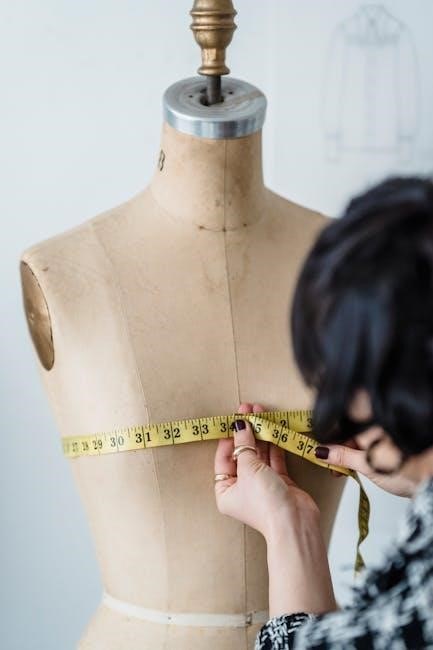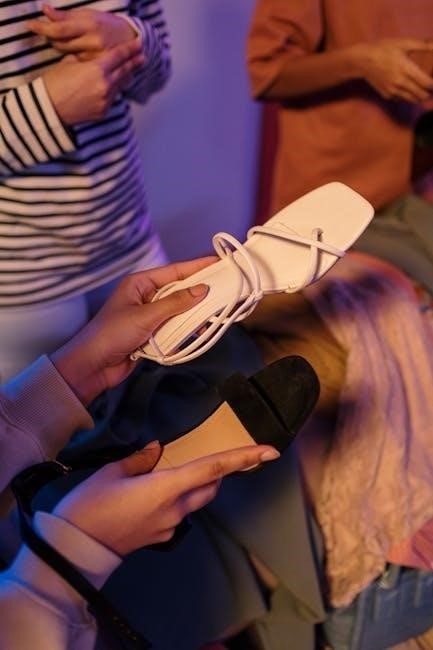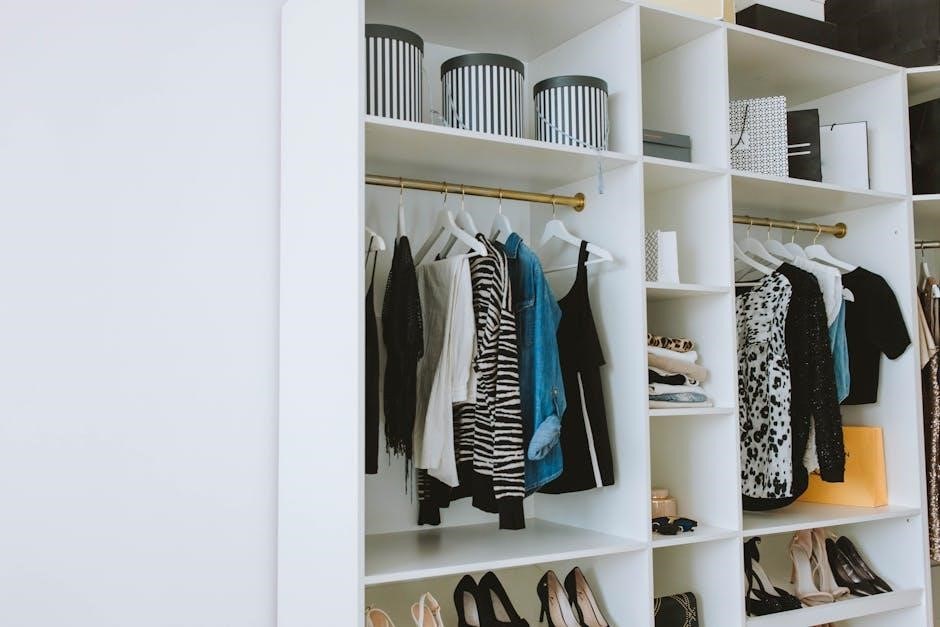Welcome to the ladies’ clothing size guide‚ your ultimate resource for finding the perfect fit. Discover how to measure accurately‚ understand body types‚ and use size charts to transform your wardrobe and boost confidence.
Understanding the Importance of Proper Sizing
Proper sizing is essential for comfort‚ confidence‚ and ensuring garments fit flawlessly. Ill-fitting clothes can lead to discomfort and self-consciousness‚ while the right size enhances your silhouette and boosts self-esteem. Accurate measurements are key to avoiding sizing mishaps‚ especially when shopping online. Many women struggle with inconsistent sizes across brands and styles‚ making it crucial to rely on measurements rather than assumed sizes. Understanding your body type—hourglass‚ pear‚ or other—helps in selecting flattering styles. Proper sizing also ensures functionality‚ like bras providing the right support or pants offering a full range of motion. Investing time in measuring and comparing sizes pays off in a wardrobe that feels tailor-made. By prioritizing proper sizing‚ you can enjoy a seamless shopping experience and a closet full of pieces that make you feel your best. This guide will help you navigate size charts and body types to achieve a perfect fit every time.

How to Measure Your Body for Accurate Sizing
To ensure accurate sizing‚ measure your bust‚ natural waist‚ and hips while standing straight. Use a flexible tape measure‚ keeping it level and parallel to the floor for precise results.

Key Measurements: Bust‚ Waist‚ and Hips
Accurate measurements are essential for determining your clothing size. The bust is measured around the fullest part of your chest‚ keeping the tape measure level and parallel to the floor. The waist is measured at its natural narrowest point‚ typically just above the belly button. For hips‚ measure around the widest part of your hips and buttocks‚ usually 7-9 inches below your waistline. These three measurements form the foundation of women’s sizing charts and help determine your body type. Stand straight and avoid twisting or slouching to ensure precision. Use a flexible tape measure for the best results. Consistent measurements across different brands and styles will help you find the perfect fit. By understanding your bust‚ waist‚ and hip measurements‚ you can confidently shop for clothing that flatters your figure and aligns with your personal style.
Standard Size Charts for Women’s Clothing
Standard size charts provide consistent measurements for women’s clothing‚ varying by region and brand. They typically range from size 0 to 12 or XS to 3XL‚ offering a guide to help determine the best fit.
US‚ EU‚ and UK Size Comparisons
Understanding size differences between regions is crucial for international shopping. US sizes are generally larger than UK sizes‚ while EU sizes often align closely with UK measurements. For example‚ a US size 8 typically corresponds to a UK size 12 and an EU size 38. These comparisons help shoppers navigate global markets. However‚ variations exist between brands‚ so it’s essential to check specific size charts. Always measure accurately and refer to brand guides for the best fit. This ensures a seamless shopping experience across borders and brands.

Dressing for Your Body Shape
Understand your body type—hourglass‚ pear‚ or rectangular—and choose styles that flatter your silhouette. Highlight your best features‚ balance proportions‚ and embrace your unique shape for a confident‚ polished look that feels truly yours.
Hourglass‚ Pear‚ and Other Body Types
Understanding your body shape is crucial for styling. The hourglass figure features a bust and hips of similar measurements‚ with a narrower waist. For this shape‚ accentuate the waist with belted dresses or tops‚ and balance proportions with A-line skirts or tailored trousers.
The pear shape has a smaller bust and broader hips. Flatter this silhouette with A-line dresses‚ flared pants‚ or tops that add volume to the upper body. Avoid clingy fabrics that emphasize the hips.
Other body types include rectangular (similar measurements across bust‚ waist‚ and hips) and apple (fuller midsection with slimmer limbs). For rectangular shapes‚ add curves with ruffled tops or flared skirts. Apple shapes benefit from high-waisted pants and empire-waist dresses to draw attention away from the midsection.
- Hourglass: Highlight your waist with belts or peplum tops.
- Pear: Balance with A-line dresses and voluminous tops.
- Rectangular/Apple: Use structured pieces to create definition.
Dressing for your body type ensures a flattering and confident look‚ enhancing your natural beauty while creating a balanced silhouette.

How to Use a Size Chart Effectively
Always measure yourself accurately and compare to the size chart. Note that sizes vary by brand‚ so check fit descriptions and reviews. Use the chart to match your measurements for the best fit.
Matching Measurements to Size Charts
Matching your measurements to size charts ensures a perfect fit; Start by accurately measuring your bust‚ waist‚ and hips using a flexible tape measure. Compare these measurements to the size chart provided by the brand or retailer. Pay attention to the numerical ranges for each size‚ as they vary slightly between brands. For example‚ a size 8 in one brand might correspond to a size 10 in another. Review the chart carefully to identify the size that best aligns with your measurements. If your measurements fall between sizes‚ consider sizing up or down based on the garment’s description or your personal preference for fit. Additionally‚ check customer reviews for insights on how a particular style fits. By systematically matching your measurements to the size chart‚ you can reduce sizing errors and enjoy a more personalized shopping experience.
Special Considerations for Different Garments
Dresses‚ tops‚ pants‚ and outerwear may require specific sizing adjustments. For dresses‚ ensure accurate hip measurements‚ while tops need proper shoulder and bust fit. Pants should match waist and inseam‚ and outerwear should accommodate chest and shoulder measurements for comfort and style.
Dresses‚ Tops‚ Pants‚ and Outerwear
When shopping for different types of garments‚ it’s crucial to consider specific sizing factors. For dresses‚ ensure accurate measurements around the bust‚ waist‚ and hips‚ as different styles like bodycon or A-line require precise fits. Tops vary in fit depending on shoulder and bust measurements‚ with some styles like off-the-shoulder or cropped tops needing extra attention. Pants require careful measurement of the waist and inseam‚ while also considering the rise and leg style‚ such as high-waisted or slim-fit designs. Outerwear‚ such as jackets and coats‚ should fit comfortably over other clothing‚ with attention to chest and shoulder measurements. Layering needs and sleeve lengths are also important factors. Understanding these nuances helps in selecting garments that flatter your body type and ensure a comfortable‚ stylish fit. Always refer to size charts and product descriptions for specific guidance on each item.